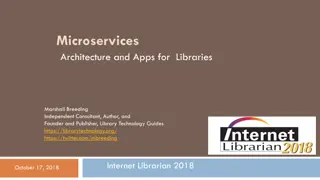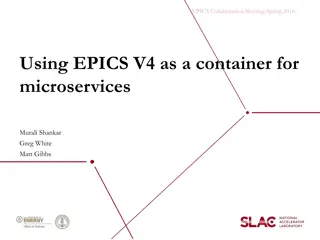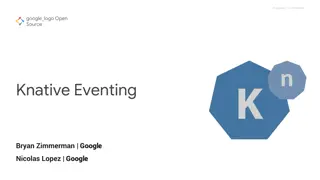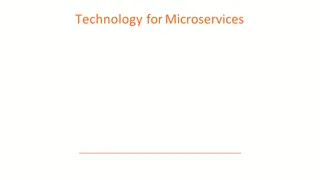Evolution of LinkedIn's Service Architecture: From Monolith to Microservices
LinkedIn transitioned from a monolithic architecture to a microservices-based approach, introducing REST along the way. Starting with their original codebase in Java, Servlets, JSP, and JDBC, they evolved to a service-oriented architecture with fine-grained services. Challenges such as test failures and complex dependencies between services were faced, leading to a shift towards microservices for better scalability and flexibility. Solutions included continuous delivery, codebase decomposition, and better-defined boundaries between tiers.
Download Presentation

Please find below an Image/Link to download the presentation.
The content on the website is provided AS IS for your information and personal use only. It may not be sold, licensed, or shared on other websites without obtaining consent from the author.If you encounter any issues during the download, it is possible that the publisher has removed the file from their server.
You are allowed to download the files provided on this website for personal or commercial use, subject to the condition that they are used lawfully. All files are the property of their respective owners.
The content on the website is provided AS IS for your information and personal use only. It may not be sold, licensed, or shared on other websites without obtaining consent from the author.
E N D
Presentation Transcript
From a monolith to microservices + REST The evolution of LinkedIn s service architecture by Steven Ihde and Karan Parikh (LinkedIn)
Leo Our original codebase Java, Servlets, JSP, JDBC Leo Oracle 4
Remote Graph Graph: member-to-member connection graph Complex graph traversal problems not suited to SQL queries RPC was used to keep it separate from Leo Our first service 5
Remote Graph RPC Leo Graph JDBC Databus Oracle 6
Mid/Back Tier Services Back tier services encapsulate data domains Mid tier services provide business logic We applied the service pattern to many domains, e.g. member profiles, job postings, group postings 7
Front Tier Services Front tier services aggregate data from many domains Transform the data through templates to present to the client Should be stateless for scaling purposes 8
Service Explosion Over 100 services by 2010 Most new development occurring in services, not Leo Site release every two weeks 9
Architectural Challenges Test failures Incompatibilities Complex orchestration Rollback difficult or impossible Complex dependencies between services 10
Microservices? Services were fine grained But monolithic build and release process did not allow us to realize the benefits of microservice architecture 11
Solutions Continuous delivery Break apart the code base Devolution of control Strict backwards compatibility Better defined boundaries between tiers 12
Continuous Delivery Shared trunk Pre- and post-commit automated testing Easy promotion of builds to production environment 13
Decentralize Codebase Separate, independently buildable repositories Shared trunk within each repository Versioned binary dependencies between repositories 14
Devolution of Control Service owners control release schedule, release criteria Service owners are responsible for backwards compatibility Services must release independently 15
Backwards compatibility Insulates teams from each other at runtime Allows service owners to deploy on their own schedule without impacting clients 16
Boundaries Between Tiers Limit aggregation to the front tier Limit crosstalk in the back tier: superblocks 17
Java RPC Difficult to maintain backwards compatibility Verb-centric APIs Use case specific APIs Difficult to navigate the proliferation of APIs 19
Rest.li plus Deco equals Microservices at LinkedIn
What is Rest.li? Rest.li is an open source REST framework for building robust, scalable RESTful architectures using type-safe bindings and asynchronous, non-blocking I/O. Primarily JSON over HTTP. 21
Why Rest.li? Polyglot (frontend) ecosystem - Java, Scala, Python, Node.js, Objective-C Uniform service interfaces (REST) 22
The Rest.li stack Rest.li Data layer and RESTful operations D2 Dynamic discovery and load balancing R2 Network Communication 23
Request Response (R2) REST abstraction that can send messages over any application layer protocol (HTTP, PRPC (old custom LinkedIn protocol)) Client - fully asynchronous Netty Server - Jetty, Netty (experimental) Rest.li D2 R2 24
Dynamic Discovery (D2) Apache ZooKeeper Dynamic server discovery Client side software load balancing D2 service Rest.li D2 R2 25
Rest.li Data using PDSCs (Pegasus Data Schemas) RESTful API that developers use to build services CRUD + finders + actions API and data backwards compatibility checking Rest.li D2 R2 26
830 Rest.li resources. 90 billion Rest.li calls/day across multiple datacenters. 65% service-to-service calls.
Aside: Normalized Domain Models Links over inclusion (denormalization) URNs are fully qualified foreign keys InfluencerPost Member Long id Long id String title String content URN author String firstName String lastName String summary URN company 29
What is Deco? URN resolution library What data you want, not how you want it 1 Time 2 3 30
Deco Example: Influencer Post Dummy Post by Karan Parikh at LinkedIn /influencerPosts /profiles /companies Hi QCon! /influencerPosts 31
Deco Example: Influencer Post deco://influencerPosts/123?projection=(title, content, author~(firstName, lastName, company~(companyName))) 32
Three services. One client call. Deco.
Rest.li plus Deco equals Microservices at LinkedIn
How Rest.li enables Microservices Rest.li + D2 facilitate domain specific services Services can easily configure clients via D2 D2 helps us scale the architecture 35
How Deco enables Microservices Deals with service explosion Abstracts away services from clients 36
Challenges Coordinating a massive engineering effort. (LiX to the rescue!) Ensuring uniform RESTful interfaces Performance 37 Rest.li API Hub
Wins All languages talk to the same service Developer productivity Reduction of hardware load balancers Ability to expose APIs directly to third parties 38
References and links Rest.li: http://rest.li/ Rest.li API Hub: https://github.com/linkedin/rest.li-api-hub Rest.li user guide: https://github.com/linkedin/rest.li/wiki/Rest.li-User-Guide Modeling resources with Rest.li: https://github.com/linkedin/rest.li/wiki/Modeling-Resources-with-Rest.li LinkedIn engineering blog posts about Rest.li: http://engineering.linkedin.com/architecture/restli-restful-service- architecture-scale http://engineering.linkedin.com/restli/linkedins-restli- moment LinkedIn s GitHub projects http://linkedin.github.io/ 43















